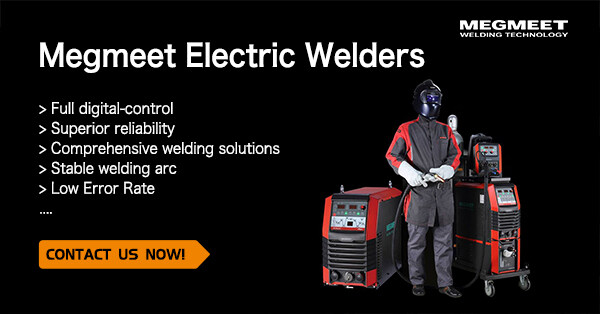I. What Is GMAW Welding?
Gas metal arc welding (GMAW/MIG), also known as wire welding, is a commonly used welding process. It is a process that forms an electric arc between the metal and the wire electrode to transmit heat to the metal pieces, and the parts achieve a bond permanently through melting and fusing.
GMAW welding is widely used in all kinds of industries that need welding manufacturing due to its higher cost-performance --- lower welding equipment acquisition expenses, higher welding efficiency, shorter welding work hours, and so on. It has many variables, so it can weld multiple welding materials and meet various welding needs.
II. Types of GMAW Welding.
GMAW welding process transferring weld metal from the arc to be base can be semi-automatic or automatic. There are four types of gmaw welding, that is globular, short-circuiting, spray, and pulsed spray.
1) Globular
The globular transfer method is a welding process in that the electrode transfers the metal to the molten pool via large droplets (also called ‘globs’). In the globular transfer of GMAW, the heat input is higher and the wire is heated for a longer period, so the weld bead appearance is sometimes hard to control. However, it’s good to weld thick welding materials.
2) Short-circuiting
The short-circuit transfer method is similar to the globular transfer method. It’s a mode of metal transfer in GMAW in which metal is transferred from the electrode to the weld pool via a series of electrical shorts. When the electrode (wire) touches the base material a short occurs and the arc goes out. The effect is a wet metal puddle that quickly solidifies and fuses the materials together.
3) Spray
In the spray transfer mode of GMAW, the wire gets melted into fine droplets that get sprayed or misted into the weld joint. This is a constant voltage process that uses a high heat input and sends a constant stream of weld metal from the arc to the base material.
4) Pulsed-spray
The pulsed spray transfer is developed from the spray arc method by eliminating the latter’s inadequacies to achieve higher welding efficiency. The welder will pulse the voltage many times per second, allowing a droplet to form at the end of the wire that gets pushed across the arc into the puddle. It is the most functional and flexible transfer time but can be the most expensive as it requires a high-end MIG welding machine.
III. Advantages of GMAW Welding.
As mentioned above, gmaw welding can outstanding in other welding methods and be widely used due to its advantages. The following are the brief advantages of GMAW welding.
1) More Versatility.
GMAW welding supports welders to weld with one hand, and the welders can easily control the welding process and welding position. It can weld various metals such as aluminum, stainless steel, and mild steel, and can be used to weld in difficult-to-reach places, such as tight corners or vertical surfaces.
2) Higher Welding Efficiency.
Being fed by continuous wire, the production capacity of gmaw welding is much higher than other processes that require more breaks for replenishment. In addition, the higher welding speed and automation bring higher welding output.
3) Less Post-weld Finishing.
GMAW welding uses shielding gas to protect the arc during the welding process, thus there is minimum spatter and slag production and less post-weld finishing is needed.
4) Minimal Losses.
Stick electrode and TIG process may always lose electrodes, but the utilization of gmaw welding is total and the spatter and slag production is less, thus there is minimum wasting material.
IV. Disadvantages of GMAW Welding.
1) Require Professional Skills
GMAW uses relatively complicated, expensive equipment compared to other processes, so it requires a good deal of skill to perform correctly. This makes it difficult for beginners or those with limited experience to produce quality welds.
2) Process Can Be Dangerous
The welding arc produces intense ultraviolet light that can damage the eyes and skin. Additionally, the fumes produced by gas metal arc welding can contain harmful chemicals, such as chromium and manganese, which can cause respiratory problems if inhaled. A small careless may cause great danger to the welders.
3) Welding Position Limitation
GMAW cannot be used in areas with a draft or outdoors since this would dissipate the shielding gas. This means that it cannot be used on vertical or overhead surfaces.
V. Application of GMAW Welding.
GMAW welding has many applications in some of the world's biggest industries and can be used for:
Manufacturing: GMAW welding is cost-efficient, easy to use and master, and can produce fast and consistent welds on various materials. It is suitable for mass production, fabrication, and repair of metal products and structures. Some examples of manufacturing applications are furniture, appliances, tools, machinery, and equipment.
Automotive maintenance and production: GMAW welding was originally developed for welding aluminum, which is a common material in vehicles. It is also used for welding other thin metals, such as steel, that require precise control and quality. GMAW welding is an essential part of the automotive production and maintenance industry, as it can join dissimilar metals, create strong and durable welds, and reduce weight and fuel consumption. Some examples of automotive applications are car bodies, frames, bumpers, exhaust systems, and engine parts.
Construction: GMAW welding is used for building and repairing various metal structures, such as bridges, buildings, pipelines, and tanks. It can weld thick and heavy metals, such as stainless steel, that require high strength and corrosion resistance. GMAW welding can also weld in different positions, such as flat, horizontal, vertical, and overhead, making it adaptable to different construction scenarios. Some examples of construction applications are skyscrapers, stadiums, power plants, and oil rigs.
Aerospace: GMAW welding is used for welding aerospace components, such as aircraft, rockets, satellites, and space vehicles. It can weld high-performance metals, such as titanium, that require high temperature and pressure resistance. GMAW welding can also create smooth and clean welds, reducing the drag and improving the aerodynamics of aerospace vehicles. Some examples of aerospace applications are jet engines, wings, fuselages, and landing gears.
Pipe welding/pipe joints: GMAW welding is used for welding pipes and pipe joints, which are essential for transporting fluids, gases, and solids. It can weld different types of pipes, such as carbon steel, stainless steel, and aluminum, that have different diameters, thicknesses, and shapes. GMAW welding can also weld in different orientations, such as horizontal, vertical, and inclined, making it suitable for various pipe configurations. Some examples of pipe welding applications are water supply, sewage, oil and gas, and chemical industries.
Shipbuilding: GMAW welding is used for welding ship components, such as hulls, decks, bulkheads, and frames. It can weld large and complex structures, such as steel plates, beams, and profiles, that require high speed and productivity. GMAW welding can also weld in different environments, such as dry, wet, or underwater, making it versatile for different shipbuilding situations. Some examples of shipbuilding applications are cargo ships, cruise ships, naval vessels, and submarines.
Custom fabrication: GMAW welding is used for welding custom-made metal products, such as sculptures, art pieces, signs, and furniture. It can weld creative and unique designs, such as curves, angles, and patterns, that require high precision and flexibility. GMAW welding can also weld different colors and finishes, such as glossy, matte, or textured, making it appealing for different aesthetic preferences. Some examples of custom fabrication applications are metal artworks, decorative items, logos, and ornaments.
Railroad track repair and construction: GMAW welding is used for welding railroad tracks and components, such as rails, ties, switches, and crossings. It can weld long and continuous sections, such as steel bars, rods, and wires, that require high quality and durability. GMAW welding can also weld in different weather conditions, such as hot, cold, or rainy, making it reliable for different railroad situations. Some examples of railroad track repair and construction applications are trains, trams, metros, and monorails.
VI. GMAW Welding Equipment and Tools.
Apart from safety equipment like auto-darkening helmets, gloves, and protective clothing, some basic gmaw welding equipment and tools are also used during welding:
GMAW welders: Top 10 GMAW Welding Machine Brands in the World (in 2023)
Welding magnets
Angle grinder
Chop saw
Soapstone
Pliers
Clamps
Chipping hammer
Band saw
The above are the basics of GMAW welding that may help you a lot during welding. If you want to buy GMAW welders and accessories, you can take Megmeet (a professional GMAW welding equipment and tools designer and manufacturer in China) into consideration. If you need to know more about Megmeet welding machines, you can contact Megmeet Welding Technology today. If you want to learn more welding tips, you can collect Megmeet News Center Page or follow our LinkedIn page.

Related articles
1. Advantages of Pulse Spray Transfer in GMAW Welding
2. GMAW vs. CO2 Welding: A Comparison of Two Metal Arc Welding Processes
3. MIG Welding VS. MAG Welding: What is the differences?
4. MIG VS TIG Welding: What are the Differences?
5. A Comprehensive Guide to Pulse MIG Welding




